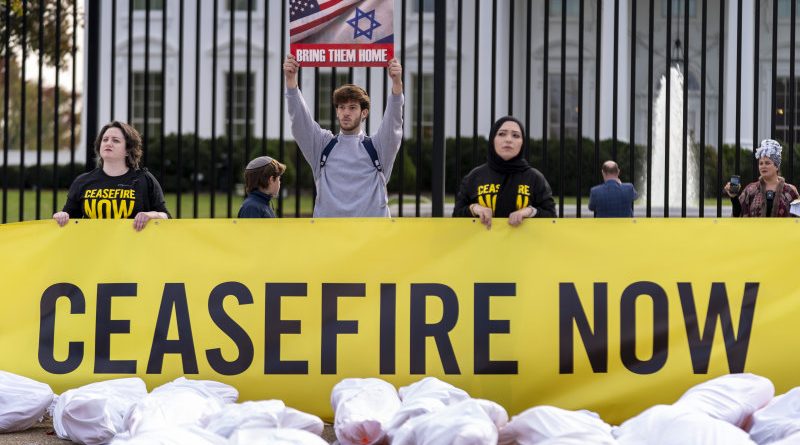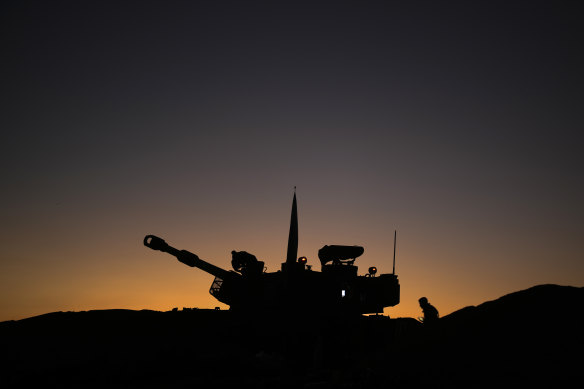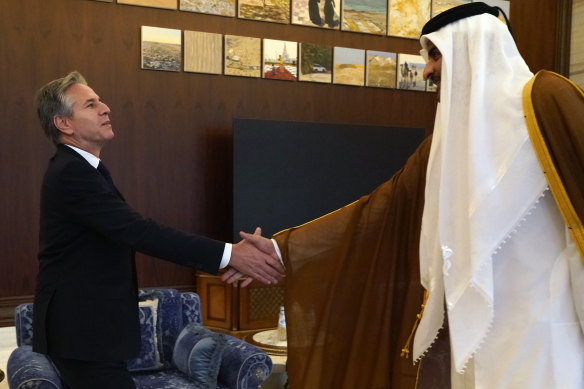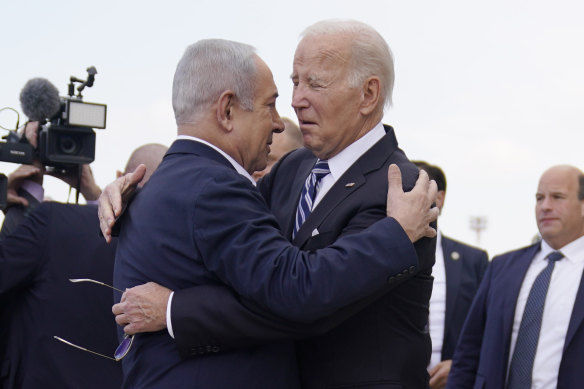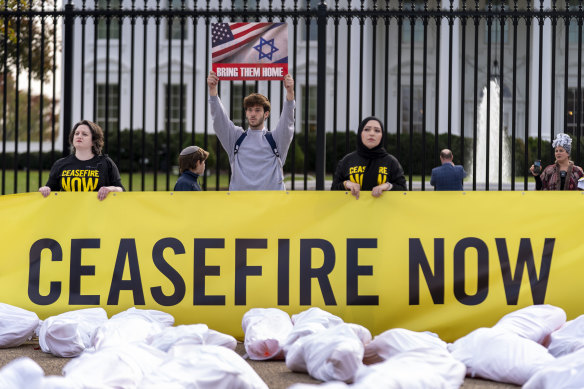Inside the secret negotiations for the Israel-Hamas hostage swap deal
Save articles for later
Add articles to your saved list and come back to them any time.
Washington: Shortly after Hamas militants took hostages during their deadly assault on southern Israel on October 7, the government of Qatar contacted the White House with a request to form a team of advisers to help free the captives.
A long-established mediator in the volatile region, Qatar approached the Biden administration with sensitive information regarding the hostages and the potential for their release, two officials involved in the effort said. The Qataris asked that a small team, which they called a “cell”, be established to work the issue privately with the Israelis.
That work finally bore fruit with the announcement of a prisoner swap deal mediated by Qatar and Egypt and agreed by Israel, Hamas and the United States on Wednesday.
Israeli artillery train their guns towards the Gaza strip on November 21. A pause in fighting is part of the deal.Credit: Getty
The two officials provided extensive details of the negotiations that led to the agreement to free 50 hostages in exchange for 150 Palestinian prisoners during a four-day pause in fighting.
The secretive effort included tense personal diplomatic engagement by US President Joe Biden, who held a number of urgent conversations with emir of Qatar, Tamim bin Hamad al-Thani, and Israeli Prime Minister Benjamin Netanyahu.
It also involved hours of painstaking negotiations including with US Secretary of State Antony Blinken, CIA Director Bill Burns, National Security Adviser Jake Sullivan and his deputy Jon Finer, and US Middle East envoy Brett McGurk, among others.
US Secretary of State Antony Blinken, left, and Qatari Emir Sheikh Tamim bin Hamad al-Thani shake hands before their meeting in Lusail, Qatar, on October 13.Credit: AP
Sullivan directed McGurk and another National Security Council official, Josh Geltzer, to establish the team. This was done without telling other relevant US agencies because Qatar and Israel demanded extreme secrecy with only a few people to be in the know, the officials said.
McGurk, a seasoned diplomat with in-depth experience in the Middle East, held daily morning calls with Qatari Prime Minister Mohammed bin Abdulrahman bin Jassim al-Thani. He reported back to Sullivan, and Biden was briefed daily on the process.
Biden had an upfront look at what the victims of the Hamas attack endured when he held an emotional, lengthy meeting on October 13 with the families of Americans being held hostage or missing.
Days later on October 18, Biden travelled to Tel Aviv for talks with Netanyahu. The official said securing the release of hostages was a central focus of the president’s discussions with Netanyahu and his war cabinet, as well as humanitarian assistance.
US President Joe Biden is greeted by Israeli Prime Minister Benjamin Netanyahu in Tel Aviv on October 18.Credit: AP
Five days later, on October 23, the White House team’s work helped yield the release of two American hostages, Natalie and Judith Raanan. From outside Sullivan’s West Wing office McGurk, Sullivan and Finer tracked in real time the captives’ difficult, multi-hour journey out of Gaza.
The return of the two Americans proved it was possible to gain freedom for hostages and gave confidence to Biden that Qatar could deliver through the small team that had been established, the officials said.
Now, the process intensified to get more hostages out. When this happened, Burns began speaking regularly with Mossad director David Barnea.
Biden saw an opportunity to gain the release of a large number of hostages and a deal for prisoners was the only realistic path to securing a pause in the fighting, the officials said.
People search buildings destroyed by Israeli airstrikes in Khan Yunis, southern Gaza., on November 18.Credit: Getty
On October 24, with Israel poised to launch a ground offensive in Gaza, the US side received word Hamas had agreed to the parameters of a deal to release women and children, which would mean a pause in fighting and a delay of the ground invasion.
US officials debated with the Israelis whether the ground offensive should be delayed.
The Israelis argued the terms were not firm enough to delay it, since there was no proof of life for the hostages. Hamas claimed they could not determine who was being held until a pause in fighting began.
Americans and Israelis viewed the Hamas position as disingenuous. The official said Israel’s invasion plan was adapted to support a pause if a deal came together.
Biden then engaged in detailed talks over the next three weeks as proposals about a potential hostage release were traded back and forth. Demands were made that Hamas produce lists of hostages it was holding, their identifying information, and guarantees of release.
The process was long and cumbersome – communication was difficult and messages had to be passed from Doha or Cairo into Gaza and back, the officials said.
Biden held a previously undisclosed phone call with the Qatari prime minister when the phasing of releases began to take shape, the official said.
Under an early draft, women and children hostages would be freed in a first phase, together with a commensurate release of Palestinian prisoners from the Israelis.
The Israelis insisted Hamas ensure all women and children come out in phase one. The US side agreed, and demanded through Qatar proof of life or identifying information for the women and children held by Hamas.
Hamas said it could guarantee 50 in the first phase, but refused to produce a list of identifying criteria. On November 9, Burns met in Doha with the Qatari leader and Mossad’s Barnea to go through the texts of the emerging arrangement.
The key obstacle at that point was that Hamas had not clearly identified who it was holding.
Three days later, Biden called the emir of Qatar and demanded to know the names or clear identifying information for the 50 hostages including ages, gender and nationalities. Without the information, the official said, there was no basis to move forward.
Shortly after Biden’s call, Hamas produced details for the 50 hostages it said would be released in the first phase of any deal.
In a November 14 call, Biden urged Netanyahu to take the deal and Netanyahu agreed.
McGurk saw Netanyahu that same day in Israel. Walking out of a meeting, Netanyahu grabbed McGurk’s arm and said “we need this deal” and urged Biden to call the emir of Qatar to agree the final terms, one of the officials said.
Talks stalled as communications went dark in Gaza.
“Terms of the Israel-Hamas ceasefire”
- All fighting in Gaza halts for four days.
- Hamas will release 50 women and children held as hostages.
- In exchange Israel will release 150 Palestinian women and children from jail.
- The truce deal will allow hundreds of trucks of humanitarian, medical and fuel aid to enter Gaza.
- Israel to extend truce an extra day for every additional 10 hostages released by Hamas.
When they resumed, Biden was in San Francisco attending an Asia-Pacific summit. He called the emir of Qatar and told him this was the last chance, and the emir pledged to apply pressure to close the deal, the officials said.
“The president insisted the deal had to close, now. Time was up,” one official said.
On November18, McGurk met in Doha with the Qatari prime minister. Burns was dialled in after he spoke with Mossad. The meeting identified the last remaining gaps towards a deal.
The agreement was now structured for women and children to be freed in the first phase, but with an expectation for future releases and the aim to bring all hostages home to their families.
In Cairo the next morning, McGurk met with Egypt intelligence chief Abbas Kamil. Word came from Hamas leaders in Gaza that they had accepted nearly all the agreements worked out the day before in Doha.
Only one issue remained, tied to the number of hostages to be released in the first phase and the ultimate structure of the deal to incentivise releases beyond the 50 known women and children, the officials said.
A flurry of additional contacts ensued, and the deal finally came together.
Protesters call for a ceasefire outside the White House on November 15.Credit: AP
Reuters
More coverage of the Hamas-Israel conflict
- Hamas had bigger plans on October 7: Intelligence about Hamas’ motivations reveals an intention to strike a blow of historic proportions and provoke an overwhelming Israeli response.
- Escape from chaos: An Australian father faced a heartbreaking dilemma – whether to flee Gaza to his children, or stay with his wife.
- Open letters: Mass resignations, boardroom turmoil and angry donors are some of the ways the Israel-Hamas war is filtering down into Australia’s high-powered arts world.
- Gaza’s youth: One of the cruellest ironies of war is that they are never started by children, yet it is children who suffer the most.
Get a note directly from our foreign correspondents on what’s making headlines around the world. Sign up for our weekly What in the World newsletter.
Most Viewed in World
From our partners
Source: Read Full Article
